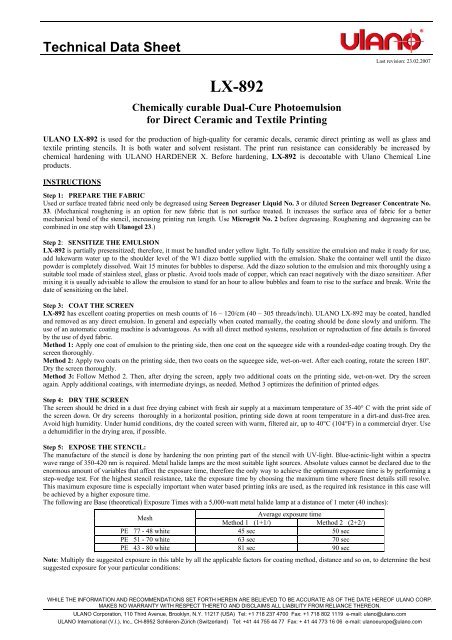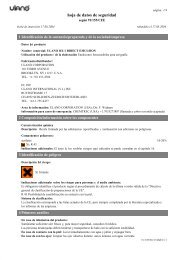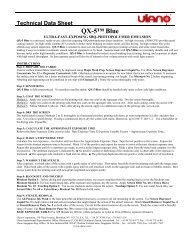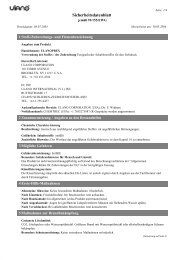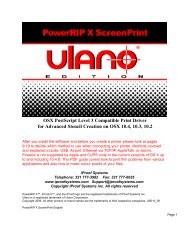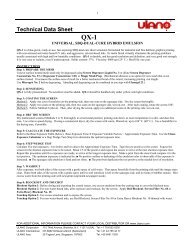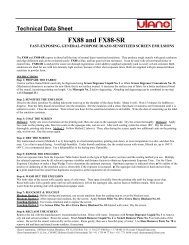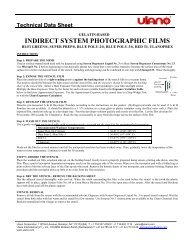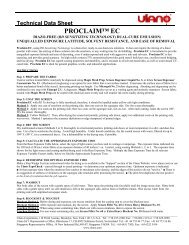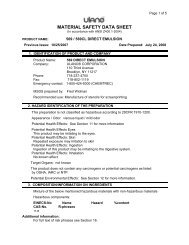Create successful ePaper yourself
Turn your PDF publications into a flip-book with our unique Google optimized e-Paper software.
Technical Data Sheet<br />
Last revision: 23.02.2007<br />
<strong>LX</strong>-<strong>892</strong><br />
Chemically curable Dual-Cure Photoemulsion<br />
for Direct Ceramic and Textile Printing<br />
ULANO <strong>LX</strong>-<strong>892</strong> is used for the production of high-quality for ceramic decals, ceramic direct printing as well as glass and<br />
textile printing stencils. It is both water and solvent resistant. The print run resistance can considerably be increased by<br />
chemical hardening with ULANO HARDENER X. Before hardening, <strong>LX</strong>-<strong>892</strong> is decoatable with <strong>Ulano</strong> Chemical Line<br />
products.<br />
INSTRUCTIONS<br />
Step 1: PREPARE THE FABRIC<br />
Used or surface treated fabric need only be degreased using Screen Degreaser Liquid No. 3 or diluted Screen Degreaser Concentrate No.<br />
33. (Mechanical roughening is an option for new fabric that is not surface treated. It increases the surface area of fabric for a better<br />
mechanical bond of the stencil, increasing printing run length. Use Microgrit No. 2 before degreasing. Roughening and degreasing can be<br />
combined in one step with <strong>Ulano</strong>gel 23.)<br />
Step 2: SENSITIZE THE EMULSION<br />
<strong>LX</strong>-<strong>892</strong> is partially presensitized; therefore, it must be handled under yellow light. To fully sensitize the emulsion and make it ready for use,<br />
add lukewarm water up to the shoulder level of the W1 diazo bottle supplied with the emulsion. Shake the container well until the diazo<br />
powder is completely dissolved. Wait 15 minutes for bubbles to disperse. Add the diazo solution to the emulsion and mix thoroughly using a<br />
suitable tool made of stainless steel, glass or plastic. Avoid tools made of copper, which can react negatively with the diazo sensitizer. After<br />
mixing it is usually advisable to allow the emulsion to stand for an hour to allow bubbles and foam to rise to the surface and break. Write the<br />
date of sensitizing on the label.<br />
Step 3: COAT THE SCREEN<br />
<strong>LX</strong>-<strong>892</strong> has excellent coating properties on mesh counts of 16 – 120/cm (40 – 305 threads/inch). ULANO <strong>LX</strong>-<strong>892</strong> may be coated, handled<br />
and removed as any direct emulsion. In general and especially when coated manually, the coating should be done slowly and uniform. The<br />
use of an automatic coating machine is advantageous. As with all direct method systems, resolution or reproduction of fine details is favored<br />
by the use of dyed fabric.<br />
Method 1: Apply one coat of emulsion to the printing side, then one coat on the squeegee side with a rounded-edge coating trough. Dry the<br />
screen thoroughly.<br />
Method 2: Apply two coats on the printing side, then two coats on the squeegee side, wet-on-wet. After each coating, rotate the screen 180°.<br />
Dry the screen thoroughly.<br />
Method 3: Follow Method 2. Then, after drying the screen, apply two additional coats on the printing side, wet-on-wet. Dry the screen<br />
again. Apply additional coatings, with intermediate dryings, as needed. Method 3 optimizes the definition of printed edges.<br />
Step 4: DRY THE SCREEN<br />
The screen should be dried in a dust free drying cabinet with fresh air supply at a maximum temperature of 35-40° C with the print side of<br />
the screen down. Or dry screens thoroughly in a horizontal position, printing side down at room temperature in a dirt-and dust-free area.<br />
Avoid high humidity. Under humid conditions, dry the coated screen with warm, filtered air, up to 40°C (104°F) in a commercial dryer. Use<br />
a dehumidifier in the drying area, if possible.<br />
Step 5: EXPOSE THE STENCIL:<br />
The manufacture of the stencil is done by hardening the non printing part of the stencil with UV-light. Blue-actinic-light within a spectra<br />
wave range of 350-420 nm is required. Metal halide lamps are the most suitable light sources. Absolute values cannot be declared due to the<br />
enormous amount of variables that affect the exposure time, therefore the only way to achieve the optimum exposure time is by performing a<br />
step-wedge test. For the highest stencil resistance, take the exposure time by choosing the maximum time where finest details still resolve.<br />
This maximum exposure time is especially important when water based printing inks are used, as the required ink resistance in this case will<br />
be achieved by a higher exposure time.<br />
The following are Base (theoretical) Exposure Times with a 5,000-watt metal halide lamp at a distance of 1 meter (40 inches):<br />
Mesh<br />
Average exposure time<br />
Method 1 (1+1/) Method 2 (2+2/)<br />
PE 77 - 48 white 45 sec 50 sec<br />
PE 51 - 70 white 63 sec 70 sec<br />
PE 43 - 80 white 81 sec 90 sec<br />
Note: Multiply the suggested exposure in this table by all the applicable factors for coating method, distance and so on, to determine the best<br />
suggested exposure for your particular conditions:<br />
WHILE THE INFORMATION AND RECOMMENDATIONS SET FORTH HEREIN ARE BELIEVED TO BE ACCURATE AS OF THE DATE HEREOF ULANO CORP.<br />
MAKES NO WARRANTY WITH RESPECT THERETO AND DISCLAIMS ALL LIABILITY FROM RELIANCE THEREON.<br />
ULANO <strong>Corp</strong>oration, 110 Third Avenue, Brooklyn, N.Y. 11217 (USA) Tel: +1 718 237 4700 Fax: +1 718 802 1119 e-mail: ulano@ulano.com<br />
ULANO International (V.I.), Inc., CH-8952 Schlieren-Zürich (Switzerland) Tel: +41 44 755 44 77 Fax: + 41 44 773 16 06 e-mail: ulanoeurope@ulano.com
Technical Data Sheet<br />
Page 2 of 2 Last revision: 23.02.2007<br />
Distance factors Fabric factors High Humidity<br />
0.50 m = 0.25 1.30 m = 1.69 Steel = 2.0 – 4.0 1.3 – 1.8<br />
0.70 m = 0.49 1.40 m = 1.95 Dyed = 1.5 – 2.0 Taped up positive<br />
0.80 m = 0.64 1.50 m = 2.25 Viscosity adjustment 1.2 – 1.3<br />
1.00 m = 1.00 1.80 m = 3.20 5% dilution 0.95 Vellum positive<br />
1.10 m = 1.21 2.00 m = 4.00 10% dilution 0.90 1.2 – 1.5<br />
1.20 m = 1.44 2.30 m = 5.29 5% more viscous 1.10<br />
Step 6: DETERMINE THE OPTIMAL EXPOSURE TIME<br />
Use the Approximate Exposure Time (the Base Exposure Time and multiply it by all relevant Exposure Variable Factors) as the central time<br />
in a Step Wedge Test (instructions can be found in the <strong>Ulano</strong> Direct Emulsions Technical Data Booklet) or with the <strong>Ulano</strong> Exposure<br />
Calculator Kit. Carry the test through to actual printing to determine your optimum exposure time. Optimum exposure is indicated:<br />
■ At that exposure time when the emulsion first reaches its maximum color density and the edges of the positive do not "resolve."<br />
■ The squeegee side emulsion is hard and not soft or slimy.<br />
■ The print best duplicates the test positive at the level of resolution that the job requires.<br />
Step 7: WASHOUT<br />
Wet both sides of screen with a gentle spray of cold water. Then spray the printing side forcefully until the image areas clear. Rinse both<br />
sides with gentle spray until no soft emulsion is left on squeegee side, and no foam or bubbles remain. Dry the frame with a rag, and blot<br />
excess water from both sides with unprinted newspaper stock, with a squeegee or with a water aspirator machine. Take care on the printing<br />
side.<br />
Step 8: BLOCKOUT & TOUCHUP<br />
Blockout: When using aqueous inks, before drying and exposing the stencil, coat the blockout area with emulsion. Dry and expose again the<br />
stencil and blockout area emulsion.<br />
When using solvent-based inks, process the stencil, dry the screen, then apply Screen Filler No. 60 or Extra Heavy Blockout No. 10. Dry<br />
the blockout areas before printing.<br />
Touchup: When using aqueous inks, touch up the screen with <strong>LX</strong>-<strong>892</strong> thinned with water. Dry and expose again the touchup emulsion.<br />
When using solvent-based inks, after making the stencil, dry the screen. Apply Screen Filler No. 60 or Extra Heavy Blockout No. 10. Dry<br />
the Screen Filler No. 60 or Extra Heavy Blockout No. 10 before printing.<br />
Step 9: OPTIONAL TREATMENT WITH HARDENER D<br />
Best results are achieved when using ULANO HARDENER D which is free from solids. For special requirements other hardeners can also<br />
be suitable. After the stencil has been made and thoroughly dried, apply Hardener D with a soft-bristled brush or sponge. Blot excess<br />
solution from the image areas. The screen requires 24 hours to cure at room temperature. To accelerate the curing process, heat the screen for<br />
one or two hours at 60°C (140°F). Note that this treatment is optional, and makes the screen virtually impossible to reclaim. Please note that<br />
the printing resistance of a screen and textile printing stencil is influenced by a lot of parameters e.g. mesh, coating technique, drying,<br />
exposure time etc. Furthermore, a lot of printing media and printing machines are being used in practice, which have not all been tested by us<br />
Step 10: RECLAIM THE SCREEN<br />
Remove ink with the appropriate solvent. Rinse the screen with water. Degrease the screen with Screen Degreaser Liquid No. 3 to remove<br />
ink residues. Rinse with forceful spray. Brush Stencil Remover Liquid No. 4 or diluted Stencil Remover Liquid No. 42 or No. 44 or with<br />
Stencil Remover Paste No. 5 on both sides of screen. Do not let stencil remover dry on the screen. Rinse with spray. Wash-out with forceful<br />
spray of water (at least 80 bar). Use Haze Remover Paste No. 78 to remove ink and haze residues. You can use Walk Away Haze<br />
Remover and activate it with Fast Acting Haze Remover, too.<br />
PRODUCT FEATURES:<br />
Color: Unsensitized: blue<br />
Sensitized: blue-green<br />
Solid contents: 48.6%<br />
Viscosity: approx. 10.000 cps<br />
VOC: none<br />
STORAGE (20 – 25°C)<br />
Unsensitized: 1 year. Protect against freezing.<br />
Sensitized: approx. 4 weeks, and up to 3 months in a refrigerator.<br />
Storage of coated screens: approx. 1 week (at 20 - 25°C and in total darkness)<br />
Note: During a longer storage of pre-coated screens, the stencil material can absorb moisture out of the environment again, therefore a<br />
repeated drying prior to the exposure is recommended.<br />
HEALTH HAZARDS/ ENVIRONMENTAL PROTECTION<br />
Please follow further information given in the material safety data sheet (MSDS).<br />
WHILE THE INFORMATION AND RECOMMENDATIONS SET FORTH HEREIN ARE BELIEVED TO BE ACCURATE AS OF THE DATE HEREOF ULANO CORP.<br />
MAKES NO WARRANTY WITH RESPECT THERETO AND DISCLAIMS ALL LIABILITY FROM RELIANCE THEREON.<br />
ULANO <strong>Corp</strong>oration, 110 Third Avenue, Brooklyn, N.Y. 11217 (USA) Tel: +1 718 237 4700 Fax: +1 718 802 1119 e-mail: ulano@ulano.com<br />
ULANO International (V.I.), Inc., Rütistrasse 17, CH-8952 Schlieren - Zurich (Switzerland) Tel: +41 44 7554477 Fax: + 41 44 7731606 e-mail: ulanoeurope@ulano.com


